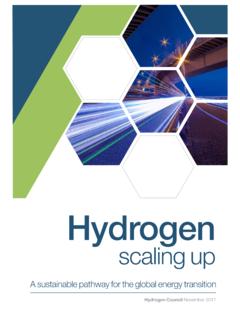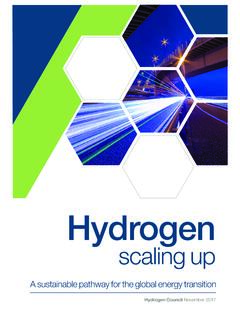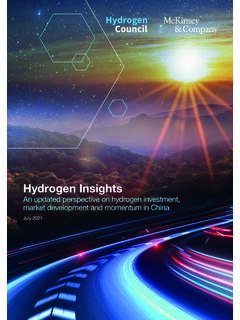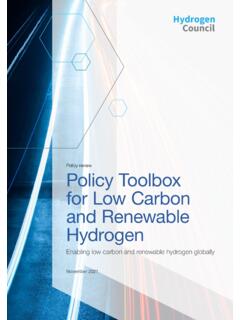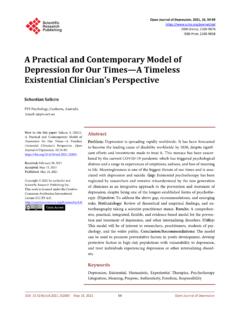Transcription of Path to hydrogen competitiveness A cost perspective
1 Path to hydrogen competitiveness A cost perspective20 January 2020 Published in January 2020 by the hydrogen Council. Copies of this document are available upon request or can be downloaded from our website: report was authored by the hydrogen Council with analytical support from McKinsey & Company and, for selected technical areas, authors of this report confirm that: 1. There are no recommendations and/or any measures and/or trajectories within the report that could be interpreted as standards or as any other form of (suggested) coordination between the participants of the study referred to within the report that would infringe EU competition law; and2. It is not their intention that any such form of coordination will be the contents of the Report and its abstract implications for the industry generally can be discussed once it has been prepared, individual strategies remain proprietary, confidential and the responsibility of each participant.
2 Participants are reminded that, as part of the invariable practice of the hydrogen Council and the EU competition law obligations to which membership activities are subject, such strategic and confidential information must not be shared or coordinated including as part of this iExecutive summary iiIntroduction and methodology 2 hydrogen is accelerating 2 The need for a hydrogen cost perspective 3 Methodology for evaluating hydrogen s cost competitiveness 51 | Cost perspective : hydrogen is already surprisingly competitive 8 Overview of cost competitiveness by application 8 Timeline for cost competitiveness 10 Drivers of cost competitiveness 122 | hydrogen production and distribution 20 hydrogen production today 20 Conditions for hydrogen production across regions and over time 21 Local hydrogen distribution 283 | hydrogen applications 32 Road transport 32 Fuel cell trains 43 Fuel cell forklifts 45 hydrogen in aviation 46 hydrogen ships 49 Heat and power for buildings 51 Heat and power for industry and the grid 56 Industry feedstock 624 | Implications.
3 How to accelerate hydrogen s cost reduction and competitiveness 66 Need for investment 66 Need for policy alignment 68 Need for market creation 69 Glossary 73 Bibliography 75iiiPath to hydrogen competitiveness A cost perspectiveExecutive summaryA path to hydrogen cost competitiveness 1 TCO defines the total costs incurred by a customer over the lifetime of using an application, including capital, operating, and financing public pressure is rising to limit global warming to degrees Celsius, global leaders are grappling with how to best take on this unprecedented challenge.
4 Full decarbonisation requires a multidimensional strategy, which has spurred renewed interest in hydrogen . Governments are recognising hydrogen s ability to decarbonise sectors that are otherwise impossible or difficult to abate such as intensive personal or collective transport, freight logistics, industrial heating and industry feedstock and its role in energy security. Meanwhile, industry leaders across the automotive, chemicals, oil and gas, and heating sectors look to low-carbon hydrogen as a serious alternative to reach their increasingly substantial sustainability objectives. The hydrogen Council s previous report, hydrogen Scaling Up , showed the critical role hydrogen could play in global industrial decarbonisation.
5 Since then, technological advances and early demonstration projects have significantly lowered the cost of many hydrogen applications. Yet despite rapid improvements in recent years and a clear prospect for further cost reduction, the competitiveness trajectory and required investments to reach the scale at which hydrogen is competitive remain unclear to report provides an evidence base on the path to cost competitiveness for 40 hydrogen technologies used in 35 applications. For policymakers, such a perspective provides firm ground on which to base financial and non-financial support that will unlock the economic value of hydrogen and to develop adequate policy frameworks. For decision-makers in industry, it brings a holistic picture of whole value chain cost dynamics and interactions, allowing them to put their own efforts into a broader up hydrogen value chain to unlock further cost reductionsOur findings suggest that scale-up will be the biggest driver of cost reduction, notably in the production and distribution of hydrogen and the manufacturing of system components.
6 This will deliver significant cost reductions before any additional impact from technological breakthroughs is considered. For instance, at a manufacturing scale of approximately million vehicles per year, the total cost of ownership (TCO)1 per vehicle will fall by about 45 per cent versus today. 30 percentage points of this cost drop is attributed to manufacturing scale up, 5 percentage points to the fall in low-carbon and/or renewable hydrogen production costs and 10 percentage points to the scale-up of hydrogen refuelling infrastructure deployment. 90 per cent of cost reduction for non-transport applications are from scaling up the supply chain On average, the cost of hydrogen supplied comprises more than 70 per cent of the TCO for non-transport applications.
7 Delivered low-carbon hydrogen costs are expected to drop sharply over the next decade and will account for up to 90 per cent of the total drop in TCOs from 2020 to 2030 across applications with shorter supply chains. Lower production and distribution costs will both contribute to lowered delivered hydrogen cost of low-carbon and/or renewable hydrogen production will fall drastically by up to 60 per cent over the coming decade. This can be attributed to the falling costs of renewable electricity generation, scaling up of electrolyser manufacturing, and development of lower-cost carbon storage facilities. ivPath to hydrogen competitiveness A cost perspectiveSecondly, distribution costs will drop significantly with higher utilisation of distribution system infrastructure.
8 For instance, with improvements in scale and utilisation, the cost of a single trucking journey of 300 km will drop by 40 per cent. Usage of existing pipeline networks may further slice these costs given sufficient utilisation. Countries with limited gas or renewable electricity sources seeking to increase use of low-cost hydrogen will benefit from lower international shipping costs, making it a viable alternative to local to 70 per cent of cost reductions for transport applications are from manufacturing scale-up of end-use equipment Scaling up manufacturing is another way to reduce costs for many hydrogen applications where costs of end-use equipment comprises a large component of TCO ( fuel cells and tanks in transportation).
9 Large-scale industrialisation of components and vehicle integration, together with lower-cost hydrogen fuel, will halve vehicle TCO in the early stages of scale-up for these and similar applications. The scale in manufacturing of equipment will account for up to 70 per cent of this reduction. A competitive low-carbon option across 22 applications by 2030A hydrogen production and distribution system at scale will unlock hydrogen s competitiveness in many applications sooner than previously anticipated. This analysis focused on 35 representative use cases and shows that in 22 of these the TCO will reach parity with other low-carbon alternatives by 2030. These 22 hydrogen applications are material: in total they comprise roughly 15 per cent of global energy consumption.
10 This does not imply that hydrogen will satisfy all this energy demand by 2030, but it does showcase that hydrogen will have a significant role to play as a clean energy vector in the future energy mix. Some examples of applications that become competitive are: Commercial vehicles, trains, and long-range transport applications will compete with low-carbon alternatives by 2030 due to lower equipment and refuelling costs. hydrogen boilers will be a competitive low-carbon building heating alternative, especially for existing buildings currently served by natural gas networks. In industrial heating, hydrogen will be the only viable option to decarbonise in some cases. hydrogen will play an increasingly systemic role in balancing the power system as hydrogen production costs drop and demand rises.

